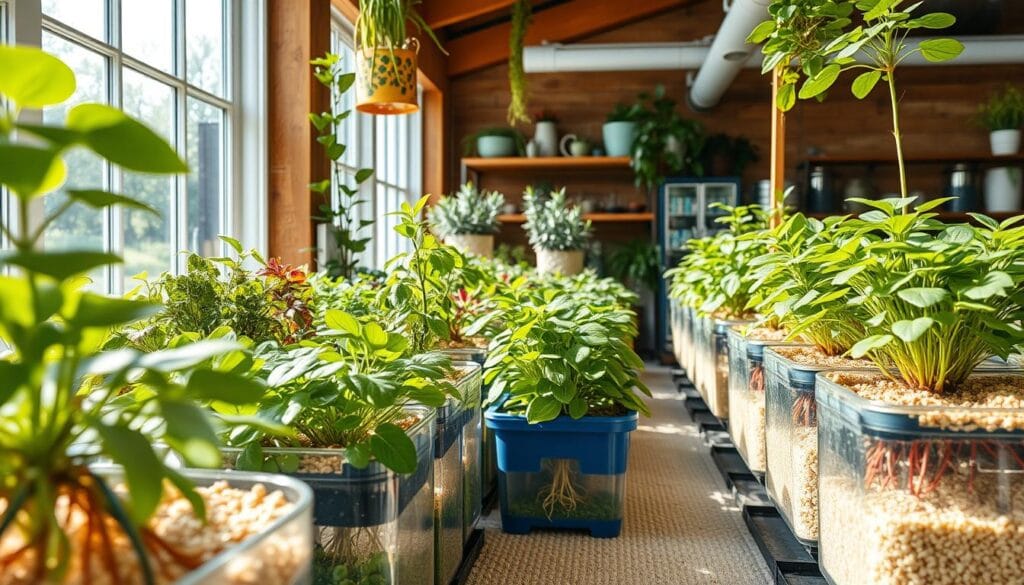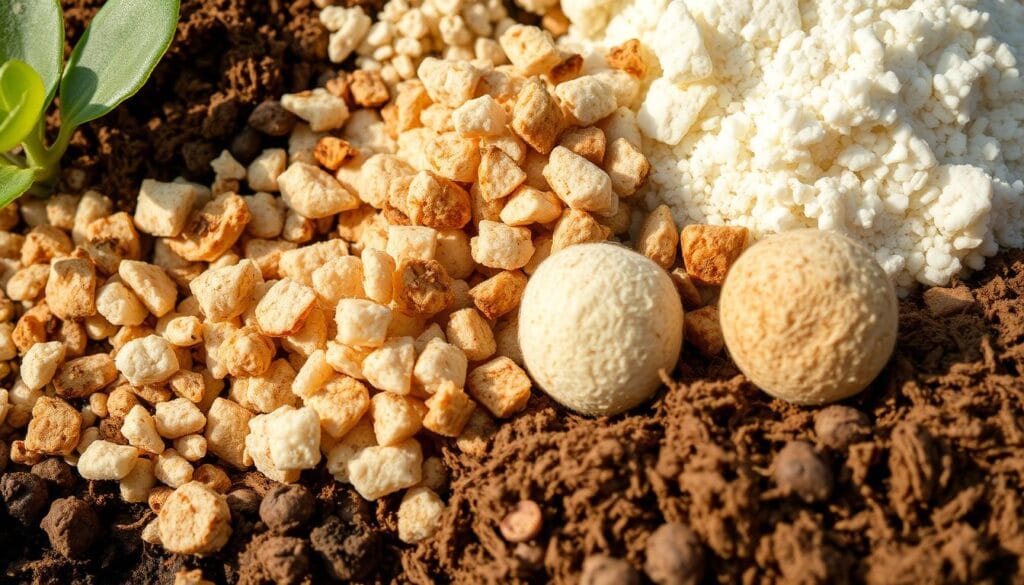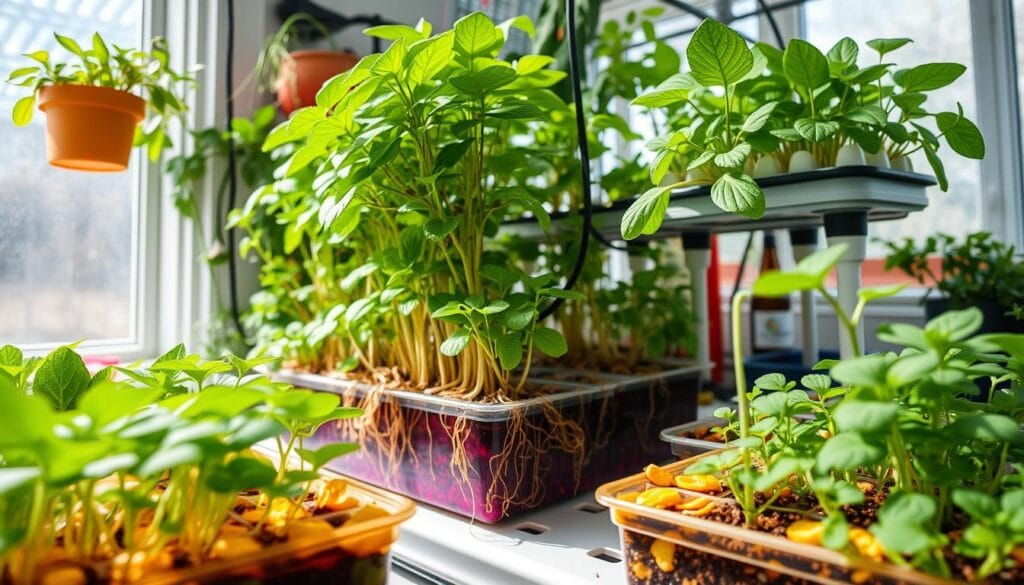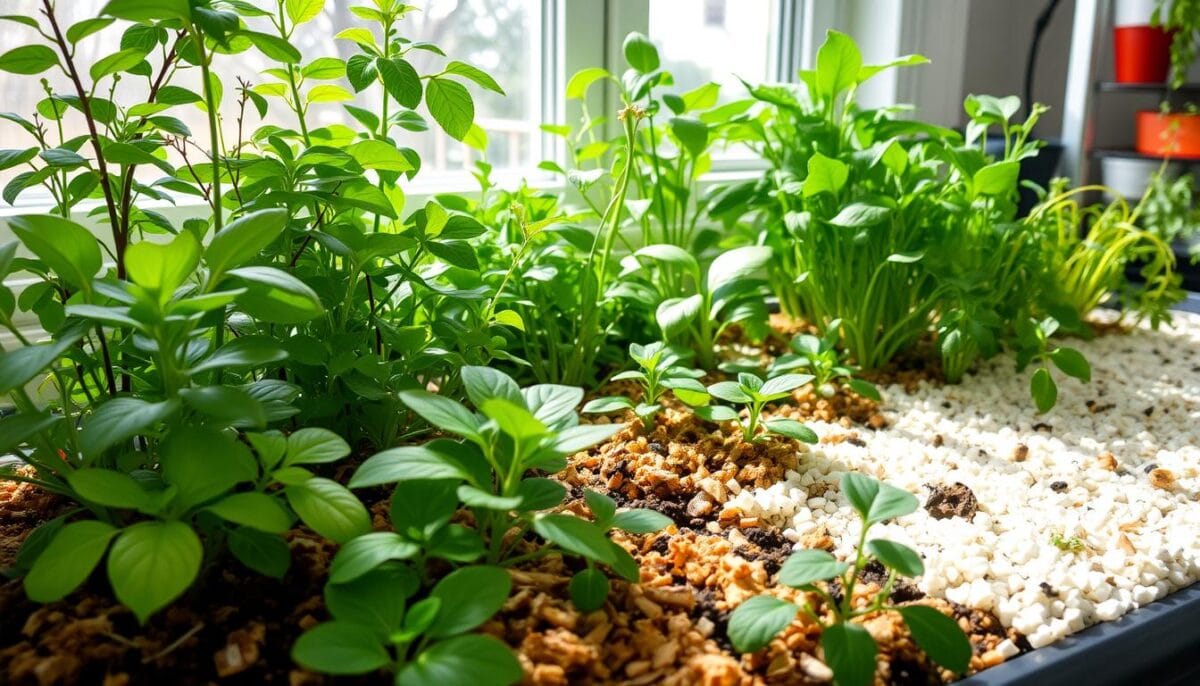Soilless potting mixes are made from organic materials, not soil. They include peat moss, coconut coir, perlite, and vermiculite. These mixes are better than soil because they offer great aeration, keep moisture, and provide nutrients for plants.
Gardeners can buy these mixes or make their own. This way, they can adjust the mix to fit their plants’ needs. Soilless cultivation helps plants grow better, faster, and uses resources more efficiently.
Key Takeaways
- Soilless media are made from organic materials like peat moss, coco coir, perlite, and vermiculite, not traditional soil.
- Soilless growing media improve aeration, moisture, and nutrient delivery for plants, leading to healthier growth.
- Gardeners can buy pre-made mixes or create their own to meet their plants’ needs.
- Soilless cultivation promotes faster plant growth and better resource use than traditional soil gardening.
- Knowing about soilless media’s components and properties is key for successful gardening and plant care.
Introduction to Soilless Media
Definition and Overview of Soilless Cultivation
Soilless growing, also known as hydroponics, lets plants grow without soil. Instead, they soak in a nutrient-rich solution. This method is great for saving space and using less water.
It’s perfect for city gardens and small spaces. Plants receive nutrients directly, promoting healthy growth.
Soilless cultivation, or soilless growing, is becoming more popular. VeryPlants leads in making top-notch soilless mixes for indoor gardens. Their mixes are light, making them easy to move around.
These blends drain quickly and hold some moisture, preventing root rot. Plus, they’re disease-free, ensuring a healthy environment for your plants.
“Soilless mixes for different indoor plant varieties are tailored by VeryPlants to meet specific needs, such as good drainage for orchids and fast-draining mix for cacti and succulents.”
VeryPlants’ mixes include organic stuff like peat moss and coconut coir. They’re made to keep plants healthy and watered. Whether you’re growing orchids or cacti, VeryPlants has the right mix for you.

Components of Soilless Growing Media
Soilless growing media mix organic and inorganic parts for plants to grow well without soil. They are made to keep plants healthy by controlling moisture, nutrients, and pH levels. Let’s look at the main parts of soilless media:
- Peat Moss – A great organic material that holds a lot of water and has lots of nitrogen, helping plants grow.
- Coconut Coir – A green choice that holds water well and is full of nutrients like nitrogen and zinc.
- Perlite and Vermiculite – These help with air and water flow, keeping roots healthy and strong.
- Compost and Vermicompost – Rich in nutrients, they help plants grow and improve the soil’s health.
- Bark and Wood Fibers – Shredded bark, like pine bark, fights off diseases and makes the media better.
Each part is important for a healthy soilless growing space for your plants. Knowing what each does helps you choose the best media for your garden.

“The key to successful soilless gardening lies in the perfect blend of organic and inorganic materials that make up the growing media.”
The Principles of Soilless Cultivation
Soilless cultivation, also known as hydroponics or substrate-based growing, has key principles for optimal plant growth. These principles ensure plants get what they need and thrive in their environment.
Aeration in Soilless Media
Aeration is vital in soilless media. It lets plant roots get the oxygen they need. The growing substrate must balance air and water well. This balance is crucial for gas exchange.
Growers use materials like coco coir, perlite, or vermiculite. These materials help create an aerated growing space.
Water Regulation in Soilless Systems
Water management is key in soilless cultivation. Growers must avoid waterlogged or too dry conditions. These can harm plants.
Automated irrigation systems and schedules help keep moisture right. This is essential for plant health and growth.
Nutrient Delivery in Soilless Solutions
Without soil, growers must give plants a balanced nutrient solution. This solution is made to meet the crop’s nutritional needs. It delivers essential nutrients directly to the roots.
Monitoring and adjusting the nutrient mix is crucial. This ensures the right pH and electrical conductivity levels.
| Key Principle | Importance | Best Practices |
|---|---|---|
| Aeration in Soilless Media | Ensures adequate oxygen supply for root growth and health | Use porous, well-draining substrates like coco coir, perlite, or vermiculite |
| Water Regulation in Soilless Systems | Prevents over- or under-watering, which can stress plants | Implement automated irrigation systems and closely monitor moisture levels |
| Nutrient Delivery in Soilless Solutions | Provides plants with a balanced, readily available nutrient source | Formulate custom nutrient solutions to meet specific crop needs, maintain optimal pH and EC |
Following these soilless cultivation principles helps growers create a perfect growing space. This supports strong plant growth and high yields. It also reduces the environmental impact of traditional farming.

Choosing the Right Growing Medium
Choosing the right growing medium is key in soilless cultivation. It affects water and air retention, nutrient availability, and pH balance. You need to think about water-holding capacity, aeration, nutrient composition, and pH for the best growing environment.
Water and Air Retention in Substrates
The growing medium’s physical properties are crucial for water and air retention. Rockwool, for example, has a high porosity, making it great for aeration and water management. Vermiculite, on the other hand, has a high cation exchange capacity and a wide pH range, requiring careful monitoring.
Nutrient Availability and pH Balance
The nutrient availability and pH balance of the medium are also key. Plants grown in certain substrates can grow taller and have healthier roots. The right medium can help plants absorb nutrients better.
Choosing the right medium depends on your plants’ needs, your experience, and how much control you want. By considering these factors, you can create the optimal conditions for your plants to thrive in a soilless system.
“Choosing the right growing medium is crucial for successful soilless cultivation since it significantly influences the plant’s availability of vital resources such as water, air, and nutrients.”
Innovative Technologies for Soilless Propagation
In the world of modern horticulture, companies like Jiffy are at the forefront. They’re creating new technologies for soilless cultivation. Jiffy Growbags offer a balanced growing space, while Jiffy Glowblocks combine lighting with the growing medium. These soilless propagation tools are changing how we grow plants.
Growbags for Optimal Space and Resource Utilization
Jiffy Growbags show the strength of innovative soilless cultivation technologies. They are small but pack everything plants need for growth into one package. This includes water, air, and nutrients. Jiffy Growbags use the latest in substrate engineering to create a perfect growing space. They help use resources well and cut down on waste.
Glowblocks: Lighting and Substrate Integration
Jiffy’s Jiffy Glowblocks are another big step forward. They mix LED grow lights with the growing medium. This combo speeds up plant growth and root development. It leads to healthier seedlings and cuttings. This new way of growing plants makes gardening more efficient and productive.
As the horticulture world keeps growing, Jiffy’s innovative soilless cultivation technologies are leading the way. They’re making horticulture more sustainable, efficient, and productive. By using soilless cultivation, growers can achieve better results in their plant propagation.
Benefits of Soilless Media for Root Growth
Soilless media in gardening is amazing for root growth. These substrates have unique benefits that boost your plants’ root health and growth.
Soilless media’s structure helps with better aeration around roots. This aeration is key for gas exchange, supporting root function and plant growth. They also balance water and drainage, giving roots the right amount of moisture and oxygen for strong growth.
Another great thing is that you can adjust nutrient levels for each plant’s stage. This makes nutrient use more efficient, saving money and reducing waste.
| Key Ingredient | Percentage in Soilless Mixes | Purpose |
|---|---|---|
| Canadian Peat Moss | 33% | Moisture retention and nutrient provision |
| Coconut Coir | 25% | Moisture retention and resistance to compaction |
| Perlite and Vermiculite | 40% | Improved drainage and nutrient provision |
Soilless media’s benefits for root growth are obvious. They offer a clean, balanced environment for plants to thrive. This makes them a top choice for gardeners looking for the best results.
Choosing soilless media for root development is a smart move. It helps gardeners get the most out of their plants, leading to amazing growth.
Moisture Management in Soilless Systems
Keeping the right moisture level is key in soilless growing. These systems drain and hold water better than regular soil. This balance makes sure all roots get the water they need, avoiding root rot or drying out.
Soilless mixes, like those with sphagnum peat moss and coconut coir, hold the right amount of moisture for plants. Knowing what each plant needs helps gardeners make the perfect mix for their plants.
| Plant Type | Ideal Soilless Mix |
|---|---|
| Orchids | Equal parts fine bark pieces and sphagnum moss |
| Cacti and Succulents | Fast-draining mix with additional perlite or gravel |
| Aroids | Balanced moisture and aeration with coir chips, perlite, charcoal, and beneficial microbes |
| Flowering Houseplants | Moisture-retentive mix with peat moss or coir |
Fertigation is a method that mixes water and nutrients for plants. It helps control moisture and nutrients, improving growth and health.
Checking runoff electrical conductivity (EC) and pH levels is important. It helps spot problems with salt or nutrient balance. Keeping the pH between 5.5 and 6.5 is essential for nutrient use and preventing deficiencies.
Managing moisture, using smart irrigation, and testing the environment are key. These steps help ensure plants in soilless systems grow well.
what is a soilless media
Soilless media, also known as soilless growing media or substrates, are materials used in plant cultivation. They don’t contain traditional soil. Instead, they are made of organic and inorganic components like peat moss and perlite. These materials provide support, aeration, water retention, and nutrients for plant growth without soil.
Potting soil products often have true dirt, including sand and clay. On the other hand, potting mixes, labeled as “soilless mix,” don’t have any dirt. They use organic materials like peat moss and add slow-release fertilizers for better drainage and aeration.
Soilless potting mixes are sterile, keeping plants safe from diseases and weeds. They are also lighter and fluffier, offering better aeration and drainage than potting soil.
Some plants need special potting mixes for the best growth. For example, orchids and succulents require specific mixes. It’s okay to reuse potting soil if it was used with healthy plants before. But, it’s best to avoid it if there were pests or diseases.
| Potting Soil | Soilless Media |
|---|---|
| Contains true dirt, including mineral elements | Does not contain any dirt, composed of organic and inorganic components |
| May contain disease-causing organisms or weed seeds | Sterile, ensuring safety from plant pathogens and weed seeds |
| Heavy, water-retaining | Lightweight, provide better aeration and drainage |
| Suitable for non-container gardening or landscape use | Recommended for container gardening |
Understanding soilless media helps gardeners and growers choose the best growing medium for their plants. This ensures the plants grow well and thrive in their environment.
Cleanliness and Scalability of Soilless Cultivation
Soilless media make growing cleaner. They are light and easy to move, making less mess than soil. This is great for indoor growing spaces where keeping things tidy is key.
Soilless media also grow well on a large scale. They grow plants in a consistent way, which is perfect for big farms. This helps farms meet the demand for fresh produce.
- Soilless media contribute to a cleaner growing environment, reducing mess and simplifying maintenance.
- The consistency of soilless substrates enables scalable cultivation practices, making them well-suited for commercial operations.
- Soilless systems eliminate the risk of soil-borne pests and diseases, resulting in healthier plants and reduced reliance on chemical treatments.
Soilless systems have more benefits than just being clean and scalable. Hydroponics use less water than traditional farming. Aquaponics combines plants and fish in a natural way. These methods are good for the planet and help farmers grow more efficiently.
“Soilless cultivation removes the risk of soil-borne diseases and pests, creating a cleaner and more controlled growing environment.”
The need for green and smart farming will keep growing. Soilless methods are becoming more popular. They help farmers grow better and reduce harm to the environment.
Conclusion
Soilless media change the way we grow plants, giving us more control and efficiency. They help us manage air, water, and nutrients better. This leads to healthier plants, more food, and better care for our planet.
Soilless media cut down on diseases and let us grow plants in different places. They’re used all over and work well with many crops. They also save water and nutrients, making farming greener.
Looking ahead, soilless media will help solve big problems in farming. We need to use resources wisely and grow food in better ways. By using soilless media, farmers can make their work better and help feed the world in a kinder way.

